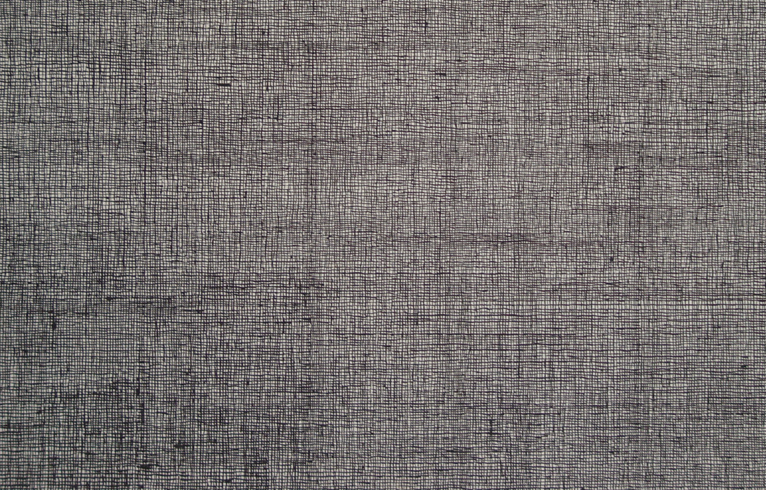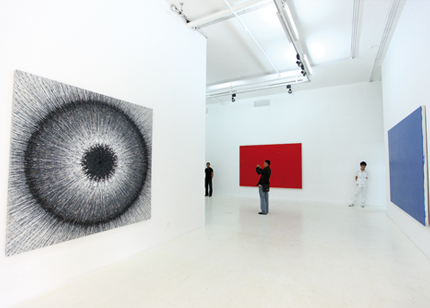THE BAMBOO CURTAIN: THREE AESTHETIC CONCEPTUALIZATIONS OF ABSTRACT ART
| February 6, 2012 | Post In LEAP 12

Perhaps, ten or twenty years from now, we will see the abstractionism of China today as something akin to American Abstract Expressionism. After the Second World War, the United States, through Abstract Expressionism, completely remolded traditional European expressionism and thereby affirmed its own status as a cultural center. In this sense, today’s Chinese abstraction serves a similar purpose. However, the contemporary context poses a paradoxical question to this kind of artistic practice: painting, a category of art in universal decline, is gradually waning in the American contemporary art world, so why have Chinese practitioners of art blithely chosen abstract art as the foundation of their cultural landscape? Whether or not this approach is an effective means of building a cultural construct is a topic worthy of consideration.
In order to more clearly outline the political situation of Chinese abstract art in the global art milieu, the Iron Curtain, a more familiar concept closely related to the Bamboo Curtain, provides a useful reference. Unlike the Iron Curtain, which remained consistent in its definition for more than 40 years, the contents of the Bamboo Curtain were vague, unstable and dissociated. The term thus reflects the introversion of the Eastern nation-states as they engaged in political, cultural and social reinvention. Today, mainstream contemporary art provides a perfect paradigm of these differing concepts, shedding light on two aspects of the East-West dichotomy. First of all, as the Iron Curtain fell in the early 1990s, the East-West political concept became a topic of fierce debate in Russia, Eastern Europe and Germany. The political aspect of art at the time was deeply rooted in the great newfound openness, creativity and acceptance that blossomed in the wake of the fall of the Iron Curtain. Secondly, the East-West dichotomy, as a cultural and aesthetic construct, was suggestive of the Bamboo Curtain concept in the way that it highlighted regionalism and subjectivity. This concept, in its manifestations in twenty-first-century Chinese abstract art, is unstable, divided, and relatively conservative, representing another facet of the vast construction of the past decade.
Today, any attempt at a conceptual description of Chinese abstract art in the first decade of the twenty-first century cannot avoid taking four exhibitions as symbolic events in the establishment of this cultural landscape. They are: in 2003, the “Chinese Maximalism” exhibition curated by the critic Gao Minglu; the critic Li Xianting’s “Prayer Beads and Brush Strokes” exhibition of the same year; Gao’s “Yi Pai—Century Thinking” exhibition in 2009; and “The Great Celestial Abstraction”exhibition of 2010, which was curated by the Italian critic and curator Achille Bonito Oliva. The symbolism of these exhibitions, as the products of three different aesthetic theories, lies in their grand conception of abstract art on both theoretical and practical levels. If all of the abstract art in the 1980s and 90s was created within the logic of Western art history or the framework of domestic “regionalization/nationalization”— an exploration of the forms, components and materials of art in modernity— then the aforementioned exhibitions were the first indications of a self-conscious rethinking of the language of art as a philosophical question. They thus made it possible for the abstract art of the day to enter the realm of contemporary art. Likewise, after 2003, more and more voices anticipated an imminent resurgence in China’s long-suppressed abstract art field. Oliva’s 2010 exhibition marked a high tide of this sentiment, which is hard to see as separate from the common appeal of these four events.
These three theoretical and practical approaches share the same object and purpose but apply different theoretical structures and perspectives to differing degrees of excavation and integration of abstract art. A discussion of the similarities and differences of these three theorizations inevitably requires an examination of the overall situation of abstract art in this time period, yielding initial answers to two crucial questions about Chinese contemporary art practice: first, as China seeks within tradition for sources with which to build its “Chineseness” while abstract art also provides this kind of potential, in what way will Chinese tradition enter the originally Western artistic language of abstract art? And second, is there a common way of thinking that underlies the foundations of these various theories, and if so, what does this commonality reveal about the overall theoretical temperament of the first and second generation of promoters of Chinese contemporary art? Looking first at 2003’s “Chinese Maximalism,” we discover that the critic Gao Minglu did not place the entire exhibition within the genealogy of abstract art. The range of this exhibition was very broad, including photography, conceptual art, installation and performance art by Xing Danwen, Qiu Zhijie, Gu Dexin and others. To put it precisely, this exhibition sought to capture a broader cultural practice based on reinterpretations of the spirit of abstract art. In order to engage in a Chinese revision of Western abstractionism, Gao Minglu drew the conceptual creative processes of duplication, experience and composition into the concept of abstractionism and extended them to the philosophical level of Chinese Buddhism. At the same time, in order to obtain a certain logical lineage within modern and contemporary Chinese art, he cast maximalism as an extension of the rational painting of the avant-garde movement. In this way, maximalism integrated two fundamentally different theories: Western rationality and the Eastern Buddhist experience. This integration is identical with the“interconnectedness” Gao ascribes to the logic of modern and contemporary art within China’s unique circumstances. This intention is even more apparent in the Yi Pai theory that Gao subsequently articulated.

Maximalism and Yi Pai theory are essentially rooted in the framework of Chinese traditional aesthetic theory, and they constitute contemporary transformations of the “artistic intent” consistently promoted by Wang Guowei, Zong Baihua,and Zhu Guangqian. The theoretical structure formed by Li Xianting in his exhibition of the same year, “Prayer Beads and Brush Strokes,” was very different. That exhibition took abstract art as its sole object of discussion without first presupposing a grand theoretical framework. Although we have plenty of doubts about the application of the spirit of Buddhism to creating a theoretical infrastructure, Li established a completely new way of looking at abstract art on two levels. First,he wrote in a frank, very Chinese vernacular, and he used the complexity of traditional Chinese craftwork as the criterion of establishing the significance of works of art. This approach demonstrated Li’s desire to completely cast off the analytical schemas of Western abstractionism and lay bare the indigenous cultural subjectivity of the artworks and their theoretical content. Second, the ultimate subject of Li’s theory was the spirit. His frequent mention of the “treatment,” “repair,” and “healing” of the soul drew Chinese tradition toward questions of philosophy and religion. In this way, he escaped the twentieth-century mainstream aesthetic tradition of discussing the East-West dichotomy in terms of pen and ink, artistic intention,form, and beauty. This breakthrough facilitated an alternative perspective on tradition.
In a sense, the theories of Gao Minglu and Li Xianting both sought to provide a system steeped in Chinese cultural subjectivity for interpreting abstract art: this is the common ethos that underlies their differences. But although these two critics did their utmost to avoid falling into the patterns of Western critical discourse, they were still influenced by modernism— the primary reference point of modern and contemporary Chinese art— and in particular, its penchant for binary schemas. Li gradually articulated “complexitism” after spending six months in 1999 engaged in in-depth study of American minimalism, and his highly conceptual emphasis on process and craft in interpreting works of art was undeniably influenced by the theoretical model provided by minimalism. Interestingly, and confusingly, Li used traditionally female tasks in Chinese culture, such as the stitching of shoe soles and the embroidery of socks, as analogues of his complexitism, while endowing Western minimalism with a certain maleness, thus positioning Eastern and Western cultures within an insinuative context. Likewise, although Gao sought to use “interconnectedness”to interpret modern and contemporary Chinese art, his theories clearly posited a contrasting target: Western modernism and postmodernism, as well as the entire theoretical tradition behind them.

It is no exaggeration to say that if critics attempt to sketch an imagined enemy, then the subject they seek to construct is already apparent. But if this kind of imagining takes place within a closed, static framework, then this aesthetic visualization can only create an attractive tableau for global culture, failing to conceive a truly dynamic cultural subject. Oliva’s “The Great Celestial Abstraction” exhibition in 2010 was an exemplar of this kind of aesthetic imagination. The exhibition catalog ceaselessly exalts China’s glorious philosophical tradition in a tone reminiscent of Marco Polo. This attitude brings to mind those Westerners who were invited to China during the Bamboo Curtain period, such as Picasso and Spencer, consistently praised in government papers as old friends of the Chinese people. Today, that sort of self-important enthusiasm seems quite ridiculous. Oliva accurately described the relatively conservative position of Chinese abstractionism as “healthy dystopia,” leaving plenty of space for the work of individual artists. However, his excessively optimistic view of the liberating value of this kind of art bordered on hyperbole. His theory basically achieved two accomplishments: first, it rigidly applied his own 1970s “cultural nomadism” theory to the discussion of Chinese abstract art, seeming to suggest that abstract art had taken on a certain spirit of criticism toward the avant-garde itself; and second, he at once reiterated the standpoints of Gao Minglu and Li Xianting, imposing and strengthening Eastern naturalism, interconnectedness and spiritualism, and simultaneously highlighted Western rationality and logocentrism. Oliva’s portrayal thus emphasized the separation and opposition between East and West.
Oliva, as a critic invited to curate “The Great Celestial Abstraction,” was acting in a capacity much different from 15 years ago, when he acted on his own initiative to promote Chinese contemporary art at the Venice Biennale. And Chinese critics and theorists thoughtlessly took Oliva’s perspective as representative of Western opinion, demonstrating that we still uphold the concept of a distinct West, even though Oliva’s individual perspective was not in fact entirely Western. Any discussion of abstract art within a static aesthetic framework incurs significant limitations. The theoretical constructs on this subject proffered by Gao Minglu, Li Xianting, and Oliva are the most important of the first decade of the twenty-first century, but they are not complete. Also relevant are the experimental black-and-white ink paintings and the nationalist and declarative “third kind of abstraction,” two trends within academic circles which explore abstraction on the basis of modernism. Abstract art in this period is undoubtedly multifaceted. Regardless of the form it takes, it is always manifest as a kind of introspective national exploration. The initial and ultimate purposes of this kind of exploration are rooted in a kind of grand cultural consciousness, and the practice of such ambitious conceptualization of cultural subjectivity always seems to draw a screen between “self” and “other.” The puzzling part is that whenever we talk about constructing an independent, diverse culture, few people can state clearly whether this screen should be torn down or reinforced. But one thing we can be certain of is that this screen is visible, mobile, and pliable. For a cultural subject to be confident and liberated, it must be established on this basis.

